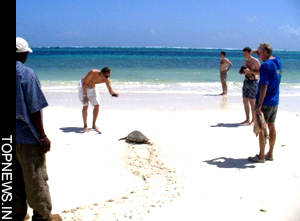Turtles and tourists are a tandem on a beach in northern Cyprus
 Girne, Cyprus - Thousands of tourists in Cyprus spend summer nights in air-conditioned hotel rooms. But a few - particularly in the northern, Turkish-Cypriot administered part of the divided Mediterranean island - choose to join conservationists on night-time, turtle-protection patrols along the beach.
Girne, Cyprus - Thousands of tourists in Cyprus spend summer nights in air-conditioned hotel rooms. But a few - particularly in the northern, Turkish-Cypriot administered part of the divided Mediterranean island - choose to join conservationists on night-time, turtle-protection patrols along the beach.
During the night, loggerhead sea turtles (Caretta caretta) and green sea turtles (Chelonia mydas), both threatened species, come ashore to lay their eggs.
A conservation group recently trooped single file through the dunes to Alagadi beach, east of the city of Girne (called Kyrenia by many Cypriots). Flashlights were not allowed.
"Newly hatched turtles orient themselves toward the moon to find their way to the water," explained Robin Snape, leader of the group of students from the University of Exeter in Cornwall, England, and Berlin's Humboldt University.
Snape was carrying two pails with newly hatched turtles that the students had gathered the previous night. He carefully placed one of them on the wet sand in the wrack line. Beamed by the moon as if by a searchlight, the little fellow crawled into the water, made a few swimming motions and was carried by the next wave into the sea.
Thus began the turtle's long journey, guided by a little-studied navigational system, to its parents in Tunisia, Egypt or Turkey.
"Just one turtle survives out of 1,000 eggs," remarked Michele Kohl, an 18-year-old who is training in Leipzig to become a commercial assistant specializing in foreign languages. A friend studying biology in Berlin persuaded him to take part in the Alagadi beach turtle conservation project, which consists of 25 volunteers.
The sandy beaches of northern Cyprus are among the most important Mediterranean breeding grounds for loggerhead turtles. Every year, from late May to early August, females come ashore at night, dig shallow pits in the sand where they lay their eggs, then cover them with sand and return to the sea.
The warmth of the sun broods the eggs, which hatch after 50 or 60 days. The student conservationists scour the beach at night and place a wire cage around every nest of eggs that they find "so that no dogs or foxes dig up the nests and eat the eggs," as Kohl explained.
"The beaches are open to tourists during the day, and we go around and inform them about the turtles," said Snape, who judged 2008 to be a good year for the creatures on Cyprus. There were some 600 nests in all: 110 on Alagadi beach, 70 near Guzelyurt and 65 east of Girne. About two-thirds of the nests were on the Karpaz peninsula, inhabited solely by wild donkeys.
"The turtles no longer come to the beaches in the south because they're full of hotels and tourists," Snape said.
The sea turtle conservation project on Alagadi beach was launched in 1992. About 20 tourists visit the conservationists' information station daily, and almost every night a few tourists go along on a beach patrol.
Once a week, during the daytime, the students open a nest to weigh and measure hatchlings in view of dozens of curious onlookers. The procedure is a fund-raising event of sorts because the turtle conservation project is totally reliant on donations. (dpa)